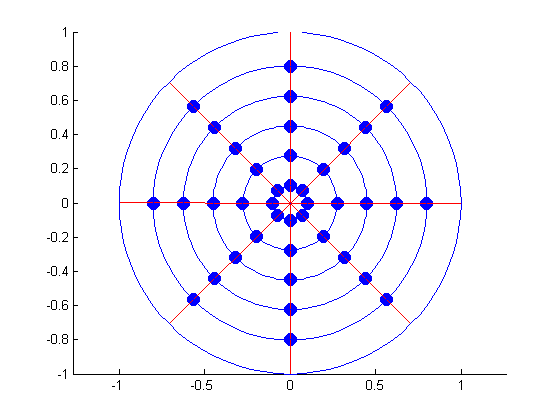I need to solve a complicated regression problem over the unit disk. The original question attracted some interesting comments, but no answers unfortunately. In meantime, I learned something more on this problem, thus I will try to split the original problem into subproblems, and see if I have better luck this time.
I have 40 temperature sensors regularly spaced in the unit disk:
These sensors acquire temperature in time. However, since time variation is much smaller than space variation, let's simplify the problem by ignoring time variability, and assume that each sensor only gives me a time average. This means that I have 40 samples (one for each sensor) and I don't have repeated samples.
I would like to build a regression surface $T=f(\rho,\theta)+\epsilon$ from the sensor data. The regression has two goals:
- I need to estimate a mean radial temperature profile $T_{mean}=g_1(\rho)+\epsilon$. With linear regression, I already estimate a surface which is the mean temperature surface, thus I only need to integrate my surface with respect to $\theta$, right? If I use polynomials for regression, this step should be a piece of cake.
- I need to estimate a radial temperature profile $T_{95}=g_2(\rho)+\epsilon$, such that at each radial position, $P(T(\rho)<T_{95}(\rho))=.95$.
Given these two goals, which technique should I use for the regression on the unit disk? Of course, Gaussian Processes are commonly used for spatial regression. However the definition of a good kernel for the unit disk is not trivial, so I'd like to keep things simple and use polynomials, unless you feel it's a losing strategy. I've read about Zernike polynomials. The Zernike polynomials seem to be appropriate for regression over the unit disk, since they're periodic in $\theta$.
Once the model is chosen, I need to choose an estimation procedure. Since this is a spatial regression problem, errors at different locations should be correlated. Ordinary Least Squares assumes uncorrelated errors, thus I guess Generalized Least Squares would be more appropriate. GLS seems a relatively common statistical technique, given that there's a gls function in the standard R distribution. However, I've never used GLS, and I have doubts. For example, how do I estimate the covariance matrix? A worked out example, even with just a few sensors, would be great.
PS I chose to use Zernike polynomials and GLS because it seems to me the logical thing to do here. However I'm no expert, and if you feel I'm going in the wrong direction, feel free to use a completely different approach.

